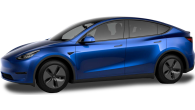Words like brutish, brash, raucous and endless World War II victory references have been used to describe Jaguar's most exciting models since, well, the end of the second world war.
For the past two decades, it's generally been because of a supercharged petrol V8 threatening the rear tyres from pretty much idle.
Hardly the last word in technology, efficiency and decorum then, and therefore not the most likely to beat the other big luxury brands to market with a dedicated fully-electric offering.
That's exactly what Jaguar has done though, trumping Audi, Mercedes, Porsche and BMW in tackling Tesla head-on.
Yes, the brilliant BMW i3 arrived here in all-electric guise in 2014, but with the plug-in hybrid version pragmatically alongside it, Jaguar is the only one to date to launch a completely combustion-free model.
It’s a bespoke design from the ground up, designed to house four adults and their luggage, promises a comfortable range akin to a tank of petrol, is available for around the cost of a mid-spec XF sedan, and is unmistakably a Jaguar. It’s also faster than plenty of those leaping cat-badged supercharged petrol V8s.
Andrew Chesterton came away from the I-Pace’s international launch very impressed, but there’s nothing like a Sydney summer’s day to really put a car to work. Particularly an electric one with so much to prove. We were among the first to drive the new I-Pace at its Australian launch this week.
Jaguar I-Pace 2019: EV400 HSE AWD (294KW)
| Engine Type | 0.0L |
|---|---|
| Fuel Type | Electric |
| Fuel Efficiency | 0.0L/100km (combined) |
| Seating | 5 |
| Price From | $87,780 - $100,870 |
| Safety Rating |
|
Is there anything interesting about its design?
Starting with a blank canvas, the I-Pace development team has come up with the same solution as most of the existing and upcoming EVs by putting an electric motor on each axle, and locating the large and heavy battery system along the floor of the body with the rest of the chassis comprised of aluminium. Jaguar boasts that the I-Pace has the brand’s most torsionally rigid structure.
##nid:72271##
What’s above the floor was arguably the biggest challenge though, with designers needing to combine the freedom of not having to house bulky traditional mechanicals with being instantly recognisable as a Jaguar.
So there’s no need for the traditional long bonnet, with that space put to better use on the inside within an expansive 2990mm wheelbase. The resulting cab-forward, tall-boy look is cleverly disguised by SUV-like side cladding and wheelarch gaps, even though the overall proportions of this ‘SUV’ don’t really conform to the customary tall, two-box shape. It’s also 64mm shorter than an F-Pace SUV.
This is a key distinction from the much bigger and 297mm longer Tesla Model S it will naturally be compared with, which seems to have been designed to look like a conventional five-door luxury hatch like the Audi A7, but ultimately results in a less useful interior for a car of its size.
There’s more detail on this under Practicality, but in a nutshell, the Jag’s taller SUV-like body leaves more room for humans above the batteries.
The I-Pace’s more coupe than SUV-like roofline helps it achieve a slippery 0.29 aerodynamic drag coefficient, and if you think it shares a similar profile to the likes of the Prius, Volt and Ioniq, it’s for this very good reason.
The inside is contemporary Jaguar though, but with surfaces and textures more aligned with the recent E-Pace SUV than the F-Pace from the year prior.
The four trim levels and numerous option packs mean there’s an array of surface options, but colours are generally subtle and materials are soft to the touch. So the designers have resisted going full rocket ship with their first EV.
How practical is the space inside?
This is where the clean-sheet design has been well applied. The all-new platform and body balances battery under floor and four seat packaging very well with outright aerodynamics.
There are five seat belts, but the cabin narrows toward the rear so the back seat seems really only suited to two adults, which will no doubt meet most expectations.
All cars on the launch were fitted with the optional fixed panoramic glass roof, which expands headroom by an extra few centimetres. With that in mind, there was ample headroom in the back seat for my 172cm height, and plenty of legroom behind my driving position.
The back seat has ISOFIX child seat mounts in the outward positions, and the long wheelbase suggests swallowing a rearward-facing child seat behind taller front seat occupants will be a snack. We’ll be putting this theory to the test ASAP.
The lack of transmission tunnel in the floor has facilitated a useful storage cubby under the dash’s centre stack, along with a generous 10-litre centre console bin. There’s the usual two cupholders front and rear, but the bottle holder count is split between large gaps in the front doors, but only room for 600ml bottles in the rear.
There are three 12-volt power outlets and four USB points spread throughout the cabin.
Despite the short tail, the boot is a wagon-like 656 litres which expands even further via a 60/40 split fold. There’s storage under the boot floor for things like charge cables and wet items, and a bonus 27-litre front boot, which is probably the best place to store the charging kit.
Unsurprisingly, there’s a compact inflation kit under the boot floor instead of a space saver or full-size spare tyre.
What are the key stats for the engine and transmission?
For all the technology that goes into making an electric car a viable alternative to what we’re all used to, it’s amazing how relatively simple the drivetrain layout tends to be.
In the I-Pace’s case, there are two motors of identical output located at opposing axles, driving each axle through dedicated single-speed transmissions.
.jpg)
Specifically, each motor is of the permanent magnet type and rated at 147kW/348Nm each, and the total system outputs are a simple combination of the two to result in 294kW/696Nm, regardless of trim level.
It would obviously be simpler again if it used one large motor, but two units helps achieve a 50/50 weight distribution and facilitates full-time all-wheel drive without the usual mechanical connection needed to link the two axles.
How much fuel does it consume?
There’s a good chance the I-Pace’s official consumption rate of 21.2kWh/100km (WLTP) means a lot less to you than its official range claim of 470km (WLTP) between charges.
We covered 192km of variable but often hard driving during our test, but can’t offer a proper analysis because it was spread across two cars. We plan to conduct independent testing, including constant highway driving ASAP.
The large 90kWh battery system is the equivalent of any Tesla with ‘90’ in its name, and is claimed to recharge from a standard homed power point at a rate of 11km/hour, which correlates to a full charge taking almost 43 hours. Jaguar assures that an overnight charge will cover the daily commuting needs for the average Australian motorist, though. The I-Pace’s charge point is located behind a flap in the left front guard.
.jpg)
You can step this up to 35km of range per hour with a Jet Charge wall box installed, which would cut the total charge time down to 13 hours and therefore alleviate the need to charge every night. Installation of the basic Jet Charge wall box will set you back at least $2280 though.
Thankfully there is the option of charging at public charge stations, but you’ll need to opt for a $425 charge cable to do so. This enables compatibility with Type 2 AC and Type 2 CCS combo DC charge points.
Jaguar claims there are currently 150 compatible charging stations nationwide, including the Chargefox ultra-rapid, Queensland Electric Highway and NRMA destination charger networks.
The current best-case charge scenario would be via the first 350kW ultra-rapid charger installed in Victoria, which promises 0-80 per cent charge in around 40 minutes, or much like super charging a Tesla.
Does it represent good value for the price? What features does it come with?
One very Jaguar trait of the new I-Pace is the variety of trim levels and option packs on offer.
.jpg)
Taking a page out of the E-Pace and Land Rover play books, the line-up is split into S, SE and HSE trim levels with list pricing staggered at $119,000, $130,200 and $140,800 respectively. For the first year of manufacture, the I-Pace will be topped by the HSE-based First Edition trim for $159,700, with a number of usually optional features fitted standard.
Key S features include 'Luxtec' faux-leather seat trim with eight-way power adjustment on the fronts, 10-inch multimedia and 12.3-inch driver instrument displays, Apple CarPlay and Android Auto connectivity, Meridian audio system, dual-zone climate control, proximity keys, LED head and tail-lights and Style 1022 18-inch alloys.
It also includes a warranty-length subscription to the 'InControl App Remote' smartphone app, which allows remote monitoring of the vehicle’s status and the ability to pre-condition the cabin temperature before you arrive at the car. Bound to be handy on particularly hot or cold days.
The SE adds leather seat trim with 10-way power adjustment and memory settings up the front, what’s described as ‘Premium LED’ headlights, a power tailgate, auto-dimming folding door mirrors, and 'Style 6007' 20-inch alloys.
It also adds to the S’s safety arsenal, with the 'Drive Pack' bringing adaptive cruise control with stop and go, high-speed AEB and blind-spot assist.
The HSE brings premium 'Windsor' leather seats, with heated and ventilated, 18-way adjustable memory fronts and heated rears, matrix LED headlights, auto powered tailgate, and Style 6007 20-inch alloys.
##nid:72273##
It expands on the SE’s Drive Pack with the 'Driver Assist Pack', with steering assist integrating with the adaptive cruise control to provide semi-autonomous ability and a 360-degree camera system.
Beyond the HSE, the First Edition adds a fixed panoramic glass roof (usually $3380), tinted windows ($845), gloss black window surrounds ($598), front fog lights ($403) and 20-inch 'Style 5070' alloys ($390 on HSE).
The inside scores First Edition sill plates, the full extended leather package to include dash and more ($2763), four-zone climate control ($1820), Alcantara headlining ($2496), First Edition-specific wood trim, the 'Cold Climate Pack' ($1060) of heated steering wheel, heated windscreen and windscreen washers, variable ambient lighting ($507), head-up display ($1040), waterproof activity key ($910), carpet mats ($299) and DAB+ digital radio ($520).
Under the skin the First Edition adds active airbag suspension ($2002), 'Adaptive Dynamics' with configurable drive modes ($2405) and 'Adaptive Surface Response' ($2002) to optimise its loose surface ability. So for the $18,900 premium over the HSE, you’re getting $23,440 worth of options.
Warranty & Safety Rating
What safety equipment is fitted? What safety rating?
All I-Paces come with six airbags, city AEB which can apply full braking force at speeds up to 50km/h and 'collision mitigation' up to 80km/h, traffic sign recognition and adaptive speed limiter, driver condition monitor, a reversing camera and 360 degree parking sensors, lane keep assist, park assist and the new clear exit monitor which will alert you of oncoming traffic before you open your door.
There’s also an 'Audible Vehicle Alert System' (AVAS) to circumvent the near-silence of the car when in motion, which is designed to warn other road users when the vehicle is approaching at speeds up to 20km/h. A further contingency is the active bonnet with external airbag to cushion impacts with pedestrians.
.jpg)
The SE upwards adds adaptive cruise control with highway AEB to extend collision mitigation up to 160km/h, and blind-spot assist.
The HSE adds steering assist, which integrates with the adaptive cruise control to provide semi-autonomous driving and a 360 degree camera system.
Despite these varying levels of safety gear, all variants have just been awarded a maximum five star safety rating from ANCAP, according to 2018 criteria.
What does it cost to own? What warranty is offered?
Unlike the rest of the Jaguar line-up’s three year/100,000km warranty, the I-Pace scores a unique five year/200,000km warranty with roadside assistance.
Service intervals are condition based, but Jaguar is throwing in free servicing for the first five years.
The battery system is covered an standalone eight year/160,000km warranty and Jaguar assures that 45 Jaguar service centres around Australia are equipped with an I-Pace specialist.
What's it like to drive?
It’s going to take a long time for me to stop getting a kick out of those first few moments in an electric car, where there’s nothing aside from dash lights to tell you it’s ready to move away in near silence. It’s like tip toeing, but without the effort.
It’s even more special when you prod the accelerator pedal and it reacts like a reflex, and generally delivers better acceleration than most combustion-engined vehicles.
.jpg)
In the case of the I-Pace, it’s claimed to be capable of reaching 100km/h in 4.8s, which, as I mentioned at the start, is as quick as plenty of recent supercharged V8 Jags.
Our drive route took us from near Sydney Airport through traffic in 30-plus degree heat, and it was kind of the ideal car for the job. It’s silent when you’re sitting still, and not much different when you’re moving, and so handy for jostling for position in traffic with the slightest flex of your right ankle.
Even the lack of blind beneath the panoramic glass roof didn’t matter because of its clever UV-resistant coating. It was hot to the touch, but didn’t make us hot.
There’s two levels of brake regeneration available, to allow for those who prefer not to feel like the car is braking itself as you lift off the throttle as it tries to harness all inertia to restore charge to the batteries.
We quickly stepped it up to the max, as once you’re used to it, youll hardly use your brakes at city speeds and who wouldn’t want to maximise the regen and therefore your range between charges?
We worked our way to the classic Royal National Park drive route, which even though it’s ridiculously speed limited these days, gave us some idea of the I-Pace’s dynamic ability.
And it’s not bad. You do feel that it’s taller, and about 150kg heavier than a high-spec BMW 5 Series, but it doesn’t embarrass itself and changes direction quite well for a car with a wheelbase a whisker under three metres.
.jpg)
The steering isn’t the last word in feel, but it still deserves the Jaguar badges, which like BMW, should have a dash of dynamism mixed with luxury.
Prod that accelerator pedal and you’re well beyond the legal limit in the blink of an eye, so a mid-week Nasho run is more nerve wracking than fun.
We swapped from a coil-sprung SE to an air-suspended First Edition for the run home, and the latter instantly proved the value of those air springs, even though it was optioned with the massive 22-inch wheels. I’d be ticking the air suspension box on my I-Pace.
We took the motorway option back to Sydney, and the I-Pace cruised along comfortably, with good sound insulation despite the absence of a traditional drivetrain effectively amplifying wind and road noise.
The biggest surprise I found was the simulated exhaust noise, which pumps a subtle fake engine note through the speakers. This only intensifies with Dynamic drive mode selected, but doesn’t make any sense to me.
If you’ve bought an I-Pace, surely you’ve sought an electric car and all the experience that brings. I’m sure it can be turned off somehow, but I can’t help but feel you’d be forced to excuse the noise when demonstrating the electric drive experience to any debutantes.
Verdict
Among the I-Pace’s list of credits, the fake engine note is a mere quibble. This is an amazing achievement for Jaguar, which not that long ago was peddling trumped-up Fords or ancient platforms draped in overtly retro designs.
It’s a luxury electric car you could not only live with, but bring your family along for the ride, with a range that should handle most weekends away without needing an ultra-rapid charger.
It’s not often we choose the most expensive model as the sweet spot of the range, but in this case I feel it’s the First Edition. Despite the extra outlay, it’s the only variant that comes with all the luxuries I’d be looking for at this end of the market, and I’d also be ticking the box for the 22-inch wheels to keep the proportions closest to the design team’s intentions.
Are you ready to go electric with Jaguar? Tell us what you think in the comments section below.
Also check out Andrew Chesterton's I-Pace review video from its international launch:





.jpg)
.jpg)
.jpg)
.jpg)
.jpg)
.jpg)
.jpg)
.jpg)
.jpg)
.jpg)











.jpg)

.jpg)
.jpg)
.jpg)
.jpg)

.jpg)


Comments